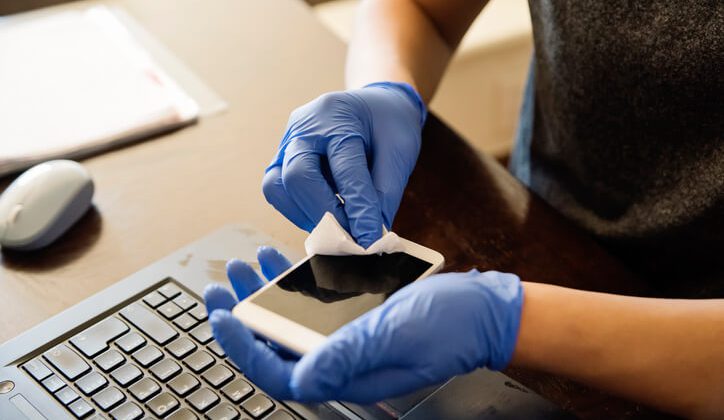Smartphones are a hotbed for bacteria, while viruses can also survive, including the atrocious COVID-19. The coronavirus can survive and remain active on metal, ceramic, glass, and plastic surfaces for several days. However, you can disinfect and clean your phone from viruses, bacteria, and any other germs with proper care. The coronavirus pandemic has taught everyone the importance of keeping everything clean, especially the gadgets that we pick up a hundred times a day that also touches our face.
Today no one can imagine life without a smartphone. It is involved in every activity, whether work, recreation, or socialising. On average, the time spent on a smartphone is 29 hours and 8 minutes per week in the UK. Similarly, an average user touches their phone 2,617 times a day, and for heavy users, the number increases to 5,427. From relying on smartphones for alarms and watching Netflix late in the night, we rely heavily on these pocket-sized devices all day long.
Table of Contents
How Do Your Mobile Phones Help Microbial Transmission?
Between touching your phone, you are likely to touch your face, surfaces around you, including the keyboard, countertops, bottles, and many others, spreading germs frequently. And along with the heavy and consistent use, it becomes imperative to clean your smartphones regularly. And not just the screen; you need to learn how to clean your phone screen, case, and every part without damaging it.
Viruses and bacteria residing on your phone surface can potentially be a threat to health. Some viruses and germs, including coronavirus, can survive on surfaces from a few hours to several days or even more, depending on the environmental condition and surface material. So, it would help if you learned how to clean your smartphone and keep it germs free because it’s as important as washing your hands regularly.
How to Clean and Disinfect Your Phone?
Unlike washing your hands, you can’t use water and soap to clean your tech gadgets. Most smartphone manufacturers, including Samsung and Apple, recommend using alcohol-based disinfecting and cleaning wipes.
Follow the steps below to clean your phone or tablet.
- Unplug and turn off your phone before you begin the cleaning process.
- Wash your hands to wash off the germs. Use soap and water. And scrub for at least 20 seconds. Or you can use a hand sanitiser to clean off the germs.
- Use an anti-bacterial wipe to wipe the outside of your phone and the screen gently. You can also use a soft cloth sprayed with an alcohol-based disinfectant containing 70% isopropyl. The 70% ratio of alcohol is essential as it’s enough concentration to kill any germs on a surface.
- However, the most important thing to avoid during the whole process is not getting any moisture in the ports or openings on the phone.
Using an alcohol-dampened microfiber cloth with 70% alcohol-based is very important as any concentration lower than that will not be enough to kill the microbes.
On the contrary, alcohol with higher concentrations will evaporate quickly and not get the required time and contact to kill the microbes effectively. Also, a higher percentage of alcohol can potentially damage the phone’s protective coating.
Note: Before you clean any of your devices, check the manufacturer’s instructions to keep the device’s tech clean and prevent damage.
Do's
- Before wiping or disinfecting your smartphone, check the content of the solution you’re about to use.
- Switch off and disconnect your phone before cleaning
- Use soft, microfiber or lint-free cotton cleaning cloth
- For smartphones, your best option is isopropyl alcohol solution or spray
- The optimal alcohol concentration is between 70% to 80%.
- Wipe the whole device, including screen, back, sides and cover
- Wipe clean your smartphone every time you return home to prevent the viruses from affecting you and your family.
Don'ts
- Never spray or put too much liquid solution directly on your phone
- Avoid pouring or letting the disinfectant into the speakers, connectors, or any other opening on the smartphone, even if it’s waterproof
- Steer clear of using hydrogen peroxide or ethyl alcohol, as they can potentially damage your phone’s oleophobic coating
- Avoid using paper towels for cleaning
- Don’t put pressure when wiping
- Avoid the use of compressed air; it can blow dirt or liquid into the phone
What Products You Can Use to Clean Your Phone?
Some of the most commonly available household products that can deal best with coronavirus and other bacteria are ethanol, hydrogen peroxide, isopropyl alcohol, and sodium hypochlorite.
Modern smartphones have an oleophobic coating that protects the screen and increases smoothness while reducing fingerprints. Isopropyl alcohol is viewed as the least harmful to the oleophobic coating. So, using isopropyl spray or wet wipes is recommended to keep the protection layer intact. For example, Apple recommends using 70% isopropyl alcohol wipe, 75% Clorox Disinfecting Wipes or ethyl alcohol wipe.
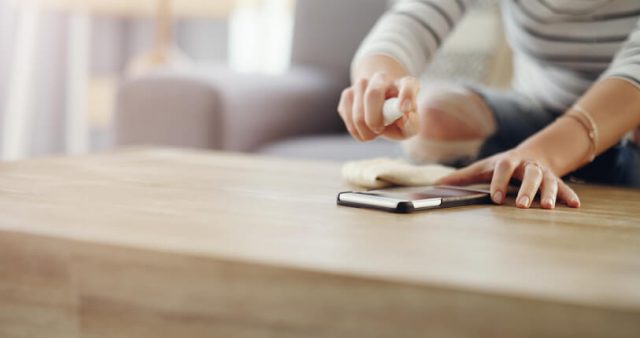
Hydrogen peroxide and ethanol should be the backup and less desirable option that is to be used when nothing else is available. Frequent use of these might ruin the oleophobic coating, which you wouldn’t want to experiment with.
The optimal concentration is about 70-80% alcohol. Purer alcohol evaporates instantly, and for better results, you need the disinfectant solution to sit on the surface for a minute. On the other hand, a lower concentration is less effective in killing viruses and germs. That’s the reason you shouldn’t rely on vodka or glass cleaner, as these compounds have lower than 70% alcohol content.
An important thing to take care of is preventing the disinfectant into the charging port, speakers, or any other opening in the smartphone, even if the phone is waterproof. Instead, take a microfiber cloth or cotton pad and soak it in the liquid, then apply it gently on all sides of the device. There’s no need to put pressure; just thoroughly and lightly wipe the whole outer surface.
Disinfectants Your Phone Screen
Another disinfectant you might come across is Chlorhexidine. Which, however, does little to protect against viruses, especially coronavirus, so it’s not recommended.
Alternatively, if chemical disinfectants don’t suit you, there are other ways to sanitise your smartphone, such as ultraviolet irradiation. Or simply, you can place your phone in a sealed plastic bag whenever you go out and then discard the bag immediately afterwards. Though, remember the virus can survive on polyethene for a long time. A plastic bag might not look very chic, but it’s still usable and keeps your phone safe from viruses and germs.
It’s not only limited to your phone. You also can’t neglect other gadgets and items that you use in public places, including smartwatches, laptops, headphones, or any such items. The most radical option would be to stop altogether touching your phone unless absolutely necessary when in outdoor conditions. The approach can also double down as an effective digital detox strategy.
How To Clean Your Phone Case?
A phone case protects your phone and touches all types of surfaces, such as restaurant tables, bathroom counters, and even the grass or ground. It’s a perfect hotbed for germs, dirt, bacteria, and viruses that can transfer to your face and hands. Phone cases are not mechanical devices; they can be cleaned using soap and water.
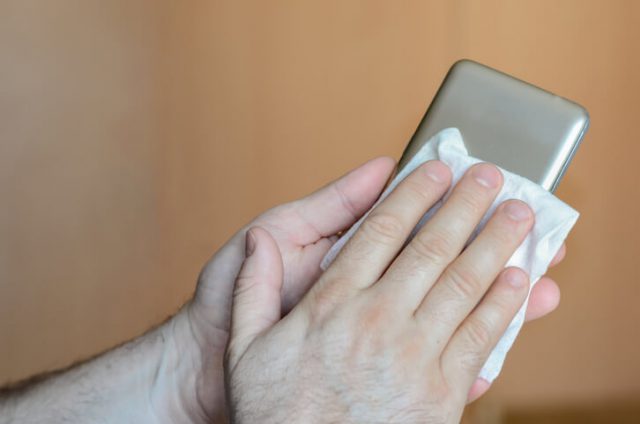
Similarly, depending on the material, you can also use alcohol wipes or an alcohol-based sanitiser. Let’s make your phone case look and feel brand new.
Using Soap and Water
First, separate your phone case from the phone before cleaning, as the liquids can damage your phone. Let’s do the cleaning:
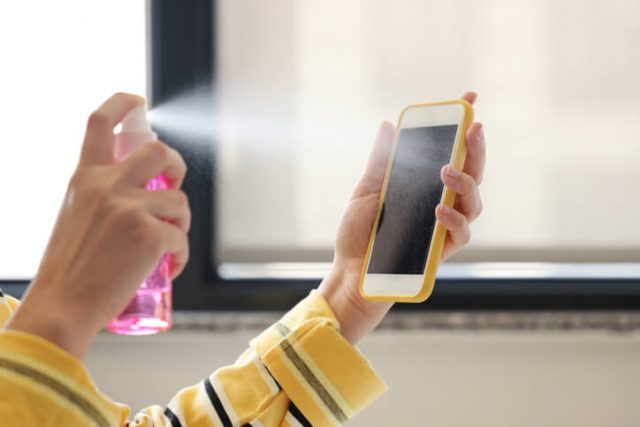
- Mix warm water and a drop of soap in a bowl. Dish soap is the best solution for cleaning silicon, plastic, and rubber. You can also use laundry detergent, hand soap, or liquid castile soap. However, if you’re cleaning a leather phone case, you need natural baby soap or gentle hand soap. And if the case is made of real wood, use plain water or wood cleaner.
- Dip a microfiber cloth, sponge, or soft toothbrush in the solution and start scrubbing the surface of the phone case with the cloth or toothbrush. Scrub the whole case in a circular or back and forth motion while trying to reach every nook and corner on the case. Clean both the outside and the inside of the phone case.
- Wash the case off and wipe clean with a soft cloth. Make sure to remove all the soapy water or cleaning solution before you dry it. Use a soft microfiber or eyeglass-cleaning cloth and let it air dry.
Disinfect with Alcohol
Use a soft cloth soaked in rubbing alcohol or alcohol-based sanitiser to clean the germs, bacteria, and viruses off the phone case. Using at least 70% alcohol with a lint-free microfiber cloth or alcohol pads can also work just fine.
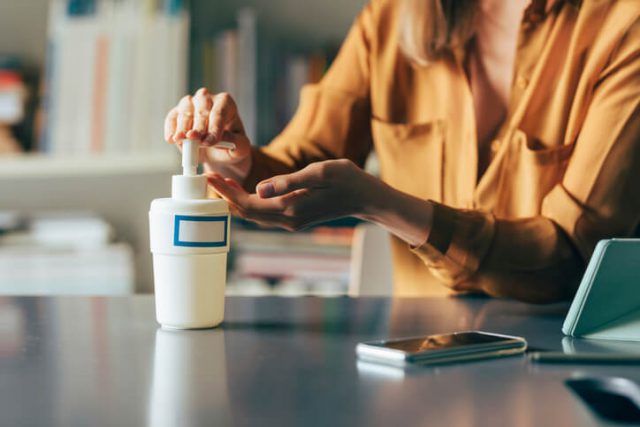
Note: In case the rubbing alcohol is a spray bottle, first spray it onto the cloth rather than the case. And use a small amount because alcohol can discolour leather over time.
- With the soaked cloth, wipe the phone thoroughly and with care to avoid damaging the surface.
- Clean the rubbing alcohol with a dry and soft cloth. Alcohol dries quickly, so you won’t have to wipe much off.
- Wait for about an hour before you can put back the phone in the case. Place the case somewhere it can air dry for some time.
You should disinfect your plastic, rubber, silicone, and wood phone cases at least once a week or even more often if you feel like you’re exposed to more contaminated places. If you have a leather case, consider switching to a case that can be easily disinfected and cleaned, such as plastic, silicone, or rubber.
How to Keep Your Cell Phone Clean
Bacteria happily reside and breed on smartphone screens and computer keyboards, especially when used by more than one person. Additionally, viruses can stick to glass surfaces for up to 96 hours, that’s multiple days’ with a high potential of infection. Therefore, whether you want to reduce the risk of coronavirus, bacterial infection, or flue, you need to perform regular cleaning of your phone.
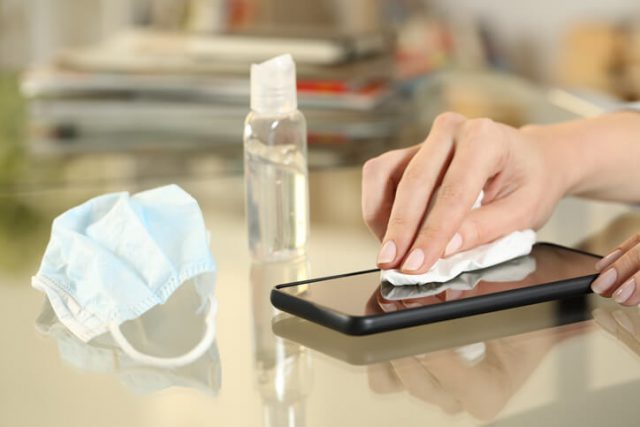
A study from the University of Arizona suggests an average smartphone has ten times more germs than a toilet seat. 9 out of 10 of these devices carry a disease-spreading microbe, such as the new coronavirus. Above all, the devices are in permanent contact with the hands.
Materials to Use as an Appropriate Disinfectant
It is important to identify the materials from which the smartphone is made before cleaning and disinfecting it. There are telephones with plastic protection and others made of glass or metal. That makes a difference when choosing the liquid to use to clean them.
If the outer casing is plastic, alcohol diluted in water is recommended, never pure alcohol. A solution of 70% alcohol and 30% water will prevent the growth of any microorganism.
The procedure is different with devices with a metal or glass body since they undergo various chemical processes to give them greater resistance. This makes them sensitive to chemicals like alcohol. If elements like alcohol are often used, the protective layer of smartphones could deteriorate to prevent the accumulation of fat or damage from blows.
Cell phones with plastic or glass protection can be cleaned with a soft, absorbent cloth to prevent the surface from damage. Also, cleaning or disinfecting substance should not be sprayed directly on the device because they can enter the interior of the equipment and damage it.
When cleaning and disinfection are carried out, it is not necessary to apply a lot of pressure on the device’s screen so as not to damage its circuits. The main thing to prevent germs from reaching us through the cell phone is not to share it, carry it in an internal pocket, and not leave it on any surface. At the same time, wash out hands with soap and water right after using the phone and essentially don’t carry the phone to the bathroom, strictly if it’s a public one.
Conclusion
It’s not only the phone’s surfaces that get dirty. Your phone’s headphones jack or the phone case can amass germs and bacteria, too. You should follow a cleaning regime and proper instructions to keep your phone free from germs and harmful bacteria that have the potential to transfer and negatively affect your health.
Keeping your smartphone germ-free might only take a few minutes but can have a significant impact on your and your family’s health safety. Also, a rule of thumb, keep your phone, earbuds, tablet, and any other accessories to yourself.
Don’t let everyone pick them up or use them. Suppose you put in a little effort, mindful practice, and efficient cleaning habits with some help from antimicrobial accessories. In that case, you can limit the spread of germs, bacteria, and viruses from your devices.
